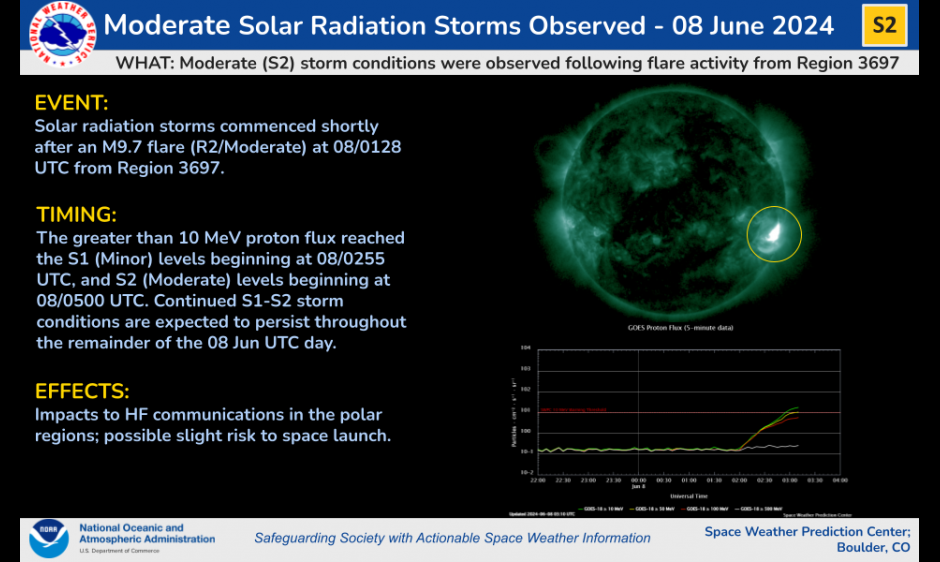
According to the National Weather Service’s Space Weather Prediction Center (SWPC), moderate solar radiation storms have been observed this Saturday morning. The area known as Region 3697 on the Sun launched a M9.7 flare causing solar radiation storms to start moments later.
According to the SWPC, continued S1-S2 level storm conditions are expected to persist throughout the remainder of June 8. This could impact high frequency communications in the polar regions, while also posing some risk to space launch vehicles.
SpaceX is planning to launch a Falcon 9 rocket with Starlink V2 Mini Satellites this morning from Vandenberg Space Force Base in California. SpaceX hasn’t provided comment yet on whether or not the radiation storms will impact their launch today.
Solar radiation storms occur when a large-scale magnetic eruption, often causing a coronal mass ejection and associated solar flare, accelerates charged particles in the solar atmosphere to very high velocities. The most important particles are protons which can get accelerated to large fractions of the speed of light. At these velocities, the protons can traverse the 150 million km from sun to Earth in just 10’s of minutes or less. When they reach Earth, the fast moving protons penetrate the magnetosphere that shields Earth from lower energy charged particles. Once inside the magnetosphere, the particles are guided down the magnetic field lines and penetrate into the atmosphere near the north and south poles.
NOAA categorizes Solar Radiation Storms using the NOAA Space Weather Scale on a scale from S1 – S5. The scale is based on measurements of energetic protons taken by the GOES satellite in geosynchronous orbit. The start of a Solar Radiation Storm is defined as the time when the flux of protons at energies ≥ 10 MeV equals or exceeds 10 proton flux units (1 pfu = 1 particle*cm-2*s-1*ster-1). The end of a Solar Radiation Storm is defined as the last time when the flux of ≥ 10 MeV protons is measured at or above 10 pfu. This definition allows multiple injections from flares and interplanetary shocks to be encompassed by a single Solar Radiation Storm. A Solar Radiation Storm can persist for time periods ranging from hours to days.

Solar Radiation Storms cause several impacts near Earth. When energetic protons collide with satellites or humans in space, they can penetrate deep into the object that they collide with and cause damage to electronic circuits or biological DNA. During the more extreme Solar Radiation Storms, passengers and crew in high flying aircraft at high latitudes may be exposed to radiation risk. Also, when the energetic protons collide with the atmosphere, they ionize the atoms and molecules thus creating free electrons. These electrons create a layer near the bottom of the ionosphere that can absorb High Frequency (HF) radio waves making radio communication difficult or impossible.